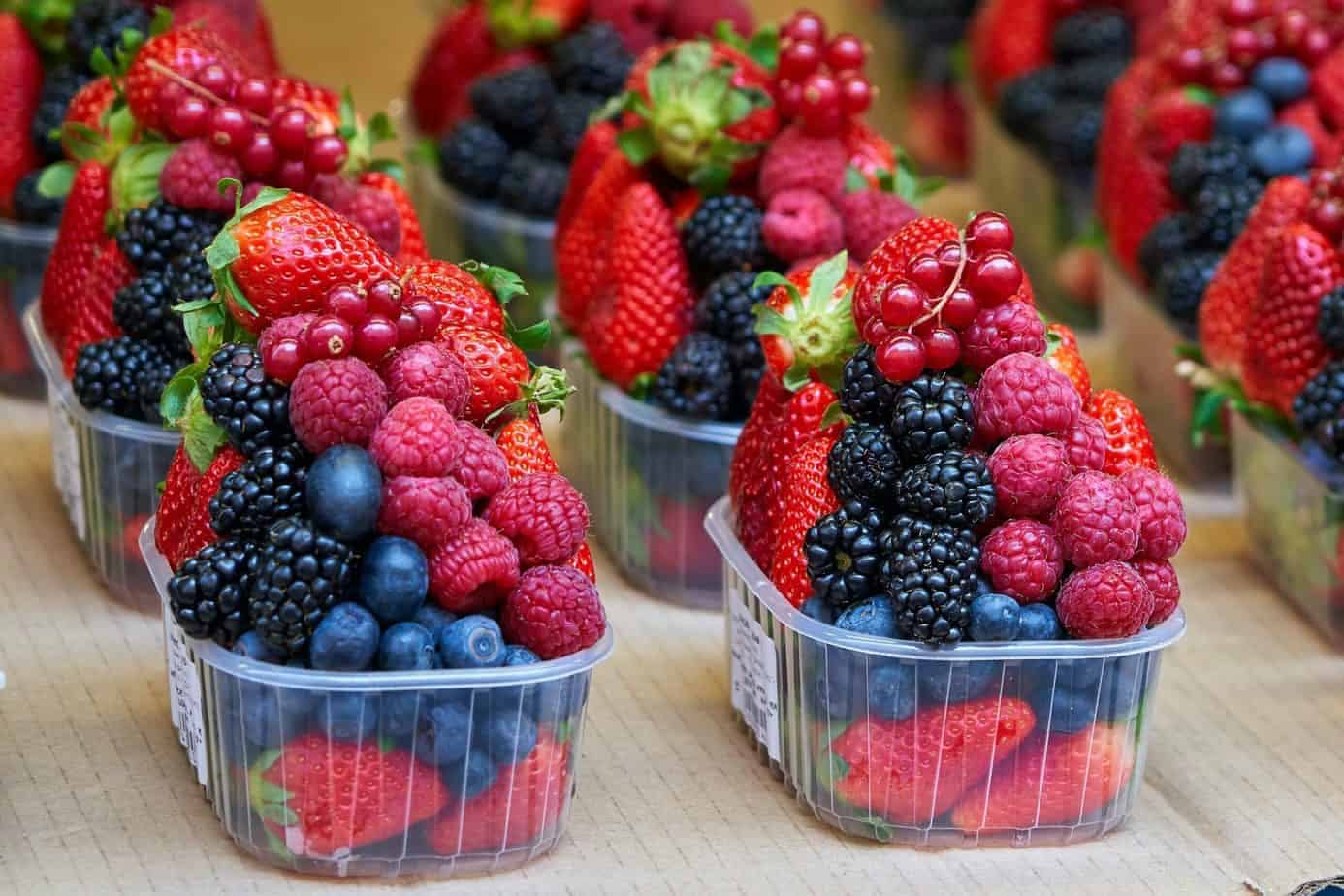


Find foods you can eat.
How much fruit is too much fruit?
Published on July 6, 2022Fruit is delicious, nutrient-dense, and plays a fundamental role in a healthy, balanced diet, but is it possible to eat too much fruit? And if so, exactly how much fruit is too much fruit? Keep reading for all you need to know!
First, let’s go over why fruit is beneficial for our overall health.
The Benefits of Fruit
Macronutrients and micronutrients
Fruit is often referred to as nature’s candy due to its sweet taste, but fruit is actually fairly low in calories and quite nutrient-dense. Out of the 3 macronutrients, carbohydrate, fat, and protein, fruit is comprised of mostly carbohydrate. It’s rich in many vitamins and minerals including vitamin C, vitamin A, folate, potassium, and more, helping you meet your nutrient needs. Most fruits are also rich in water, which not only helps you stay hydrated, but also promotes satiety so you feel full after eating.
Fiber
Fruit contains fiber, a nutrient that the average American doesn’t consume enough of. Since fiber makes us feel full, it can help decrease our chances of overeating and thereby aid in weight management. Fiber also helps lower cholesterol, promotes stable blood sugar levels, optimizes digestive function, lowers our risk for developing certain cancers and diverticular disease, and feeds our good gut microbes, promoting a healthy gut microbiome. While some fruits are higher in fiber than others, all fruit contains some fiber and incorporating fruit into your diet can help you meet your daily fiber goal. Berries in particular, are notorious for being some of the highest fiber fruits you can consume. For example, raspberries contain an impressive 8 grams of fiber per cup, which is nearly 30% of the daily value for fiber.
Antioxidants
Fruit provides a variety of phytochemicals, or naturally occurring compounds in plants that confer various health benefits when we consume them. Antioxidants fight free radical damage, protecting our cells from oxidative stress and reducing our risk for developing chronic diseases associated with inflammation, including cardiovascular disease and certain cancers. In fact, a recent meta-analysis demonstrated that higher intakes of fruit (and vegetables) are associated with lower mortality risk. So if you eat fruit daily, you may increase your lifespan!
Can you eat too much fruit?
As with any food, it is possible to overconsume fruit, but the average person doesn’t need to be too concerned about moderating their fruit intake, since the benefits of consuming fruit outweigh the negative implications of eating a bit too much. Additionally, it’s more common to overdo it on highly processed foods compared to fruit, since these foods often lack fiber and other satiety-inducing nutrients, are highly palatable and are engineered to be desirable.
That said, it is important to recognize that fruit is a carbohydrate source and when planning your meals and snacks, this should be taken into account.
All fruits contain naturally occurring sugar, but when we eat a piece of whole fruit, the sugar it contains doesn’t affect us quite like added sugars found in processed foods and sweeteners do. This is because the fiber and water found in whole fruit fill us up, and the fiber also slows the rate at which we absorb sugar from fruit. A cookie or spoonful of honey, on the other hand, may contain a similar amount of sugar, but they lack fiber and water, so they won’t be as filling. Without fiber to slow their absorption, sugar will be rapidly absorbed, causing blood sugar spikes shortly after they’re ingested.
Blood sugar spikes trigger insulin release, a hormone that pulls sugar into our cells to be used or stored, then causing our blood sugar to drop. Insulin spikes that often result from eating simple sugars (particularly in larger quantities) may cause a “sugar crash,” after our blood sugar dips. This is why we may feel hungry, shaky, and irritable an hour or two after consuming a sugary food or beverage.
When we eat fruit, our blood sugar will still rise, but more slowly. Our insulin will also be released more gradually, so we are less likely to experience a sugar crash after eating a serving or two of fruit. Still, it’s always a good idea to pair any carbohydrate-rich food with a little protein and/or fat to further slow the absorption of sugar into the bloodstream and promote blood sugar stability. This is particularly important if you have insulin resistance or diabetes, or if you are looking to manage your weight. This can look like adding a spoonful of peanut butter to a sliced apple, pairing your banana with some Greek yogurt, or munching on a handful of pumpkin seeds with your grapes.
Some fruits contain more sugar than others, for example, figs, grapes, and certain tropical fruits like bananas, mango, and pineapple tend to be slightly higher in sugar, whereas berries, citrus fruits, melons, and stone fruits tend to be lowest in sugar. This doesn’t mean we should all avoid higher sugar fruits, but if you are concerned about managing your blood sugar or weight, this may be helpful information to take into consideration.
What about fruit juice and dried fruit?
Unlike whole fruit, fruit juices are stripped of their fiber and are highly concentrated, so our bodies process them more similarly to added sugars. Freshly squeezed juices may contain vitamins, minerals, and antioxidants, but this doesn’t necessarily make them a health food. One glass of orange juice, for example, contains around 3 whole oranges but chances are, it is unlikely that you would eat 3 whole oranges in one sitting. Without any fiber, the glass of orange juice won’t fill you up, whereas eating 3 whole oranges would be quite filling.
Similar to fruit juices, dried fruit is a more concentrated source of sugar compared to fresh fruit, since the water is evaporated away. Dried fruit still contains fiber, but without the natural water content of fruit, it’s easy to over-consume without feeling full. Again, this doesn’t necessarily mean you should avoid dried fruit, but for optimal glycemic control, it’s important to be mindful of portion sizes and aim to pair your dried fruit with a handful of nuts, seeds, or any other protein and/or fat sources that suit your dietary needs.
How much fruit should you eat?
Current federal guidelines recommend that adults consume between 1½-2 servings of fruit per day, which is equivalent to 1½-2 cups of fresh fruit. Since dried fruit is more concentrated, one serving of dried fruit is equivalent to about ¼ cup for most varieties. Fruit juice made from 100% juice counts towards your daily fruit intake, however, one serving is only about ½ a cup. Adding fruit to a snack, having it as a dessert, or incorporating it into meals will provide you with significant health benefits and is also a nutritious way to satisfy a sweet tooth.
Should anyone avoid fruit?
Fruit is an important component of a healthy diet and avoiding it is not recommended for the average person. Certain populations may need to avoid fruit or certain fruits for a medical reason, such as those with food allergies to specific fruits, or those following a ketogenic diet for a medical reason, such as epilepsy.
Individuals with type 2 diabetes may need to moderate their fruit intake depending on their blood sugar levels, but they do not need to (and should not) avoid fruit altogether. In fact, the antioxidants, fiber, vitamins, and minerals found in fruit can help lower inflammation and promote insulin sensitivity. Further, current nutritional recommendations for those with diabetes encourage the consumption of fruit. Those with diabetes might consider selecting fruits that are especially high in fiber, such as berries, and should be cognizant of pairing fruits with protein and/or fat sources.
The Bottom line
Just because fruit contains sugar, doesn’t mean we should fear it! Fruit confers numerous health benefits, and its consumption is associated with longevity. As with the overconsumption of most foods, eating fruit in excess can lead to weight gain and blood sugar instability. That said, in the U.S., overeating heavily processed foods is far more common than overeating fruit. If you are looking to lose weight or manage your blood sugar, cutting back on your fruit intake should be low down on the list of dietary adjustments to implement.
Following a complicated diet or avoiding specific ingredients? Give the Fig app a try! Simply tell Fig how you eat, and Fig will show you thousands of products that likely fit your needs. Scan products at the grocery store to see if they work for you.
 From the Founder: January Reflections
From the Founder: January Reflections What Exactly Are “Natural Flavors”?
What Exactly Are “Natural Flavors”?